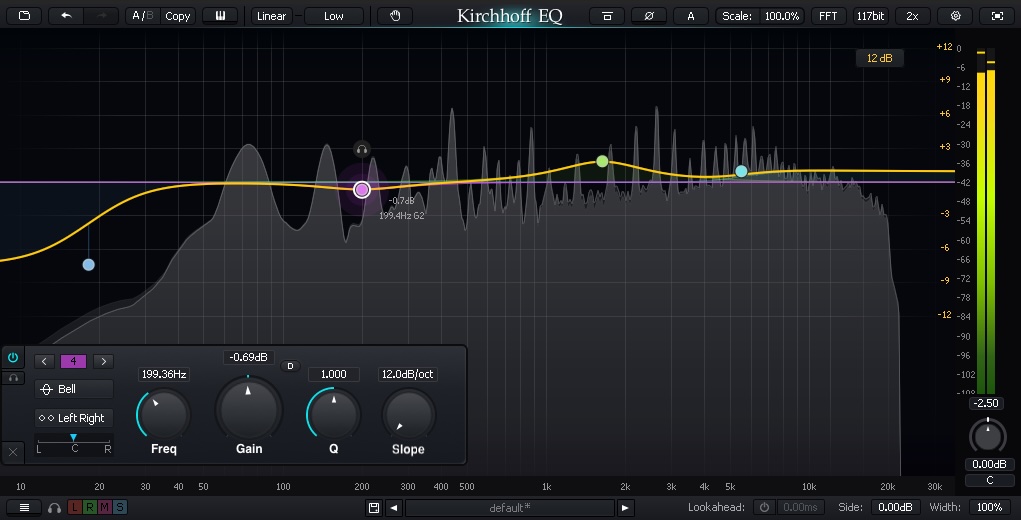
Kirchhoff-EQ: Transparent, Intelligent Parametric EQ for Mastering
Tansel Günay (aka Punkat) — Punkat Music Sàrls | Steinsel/LUXEMBOURG

Kirchhoff-EQ blends a flexible 32-band architecture with 117-bit internal precision, comprehensive phase modes (Minimum / Analogue / Linear / Mixed), and an exceptional dynamic EQ. It delivers transparent tone balancing and surgical problem-solving in one place. Below you’ll find the mastering-critical features and practical starting points.
Quick Summary
- 32-band parametric EQ — independent F/G/Q/S per band.
- 117-bit ultra-high precision — minimizes cumulative amplitude/phase error for micro-dB moves.
- Phase Modes — Minimum (near-zero latency), Analogue (prototype compensation), Linear (phase-true; beware pre-ringing), Mixed (minimum in lows, linear up high).
- Dynamic EQ — Above/Below dual sections, Detect/Relative double-envelope, sidechain, L/R and M/S detection.
- M/S & L/R routable bands — precise stereo shaping where it matters.
- 2× Oversampling — improves dynamics aliasing/quantization-noise distribution.
- Lookahead (0–20 ms) — smoother dynamics with fewer transient artifacts.
- Auto Gain + Global Scaling — honest A/B, fast macro trims while preserving the curve.
- Sound Modes — Legacy (thicker low-end), Tight (punchy), Tight + Adaptive Noise Shaping (extra clarity around ±1 dB).
Key Areas & Tuning Tips
1) Phase Modes
- Minimum-Phase: most natural transients; go-to for general use.
- Linear-Phase: keeps phase intact; watch for pre-ringing on percussive content.
- Mixed-Phase: boundary ~300–600 Hz; minimum below, linear above — a safe mastering middle ground.
- Analogue Prototype: amplitude/phase compensation; ~63-sample latency.
2) Dynamic EQ
- Above/Below: separate ratio/range/attack/release for over/under threshold.
- Detect vs Relative: local band vs overall mix energy → context-aware decisions.
- M/S/L/R Detection: e.g., tame sibilance only on Sides; compress Mid low-end.
- Lookahead 5–12 ms: transparent transient management.
3) M/S & Stereo Control
- Assign each band to Mid/Side or Left/Right as needed.
- Stereo Width & Side Gain: macro stereo shaping via bottom bar controls.
- Allpass filters (phase shaping) — note: ineffective in Linear phase.
4) Precision & CPU
- 117-bit and 2× OS: A/B them; balance CPU/latency vs benefit.
- Visual dB range: keep at 3–6 dB in mastering for finer control.
- Auto Gain: fair A/B; commit final level elsewhere.
My Starting Points (Mastering)
- Phase: Mixed-Phase, boundary ≈ 400–500 Hz (material-dependent).
- Sound Mode: Tight + Adaptive Noise Shaping.
- Precision: 117-bit on (A/B if CPU is tight).
- Oversampling: 2× (especially if using dynamic bands).
- Lookahead: 6–10 ms (on dynamic bands).
- Visual dB range: 6 dB → micro moves (±0.3–1.0 dB).
- Global Scaling: if feedback says “too much,” pull gains to ~70–85% globally.
Filter Types (Short Guide)
Core
Bell, Low/High Shelf, Tilt, Flat-Top, HP/LP, Notch, Band-pass, Brickwall, Allpass.
Tip: Sword excels at ultra-narrow resonances.
Vintage Models
Brit N (Neve-ish), Console E/G (SSL), Vintage Tube, Tone Stack, EQ-250, Blue.
Tip: For musical broad strokes, BritN/Tube shelves are lovely.
Mastering Scenarios — Step-by-Step Solutions
1) Harsh Upper-Mids (2.5–4.5 kHz) — Vocals & Guitars
- Band: Bell (Q 1.5–2.5), F ≈ 3.2 kHz, Gain start at 0 dB.
- Dynamics: Above on; Ratio 40–60%, Range −1.5…−3 dB, Attack 10–20 ms, Release 80–150 ms, Lookahead 6–10 ms.
- Phase: Mixed-Phase. Note: Linear can pre-ring on percussive content.
- Bonus: Relative 60–80% for context-aware suppression.
2) Sibilance (6–10 kHz) — Only Annoying on Sides
- Routing: set band to Side channel.
- Detect/Relative: Detect = 7–8 kHz; Relative = 200–500 Hz → engage when highs rise without lows.
- Dynamics: Above; Ratio 40–55%, Range −1…−2 dB; Attack 5–10 ms; Release 60–120 ms.
- Result: preserves stereo width while polishing the top end.
3) Low-End Cleanup (80–200 Hz) — Mid Muddiness
- Routing: Mid channel; low shelf or narrow Bell.
- Dynamics: Below on (prevents bloom in quiet parts); Ratio 30–50%, Range −1…−2 dB.
- Phase: Minimum or Mixed (Linear may soften kicks).
- Extra: small Side shelf +0.3…+0.6 dB at same area to open the scene.
4) Kick–Bass Clash (50–120 Hz)
- Band A (Kick): 60–80 Hz Bell, dynamic Above; Attack 10–25 ms, Release 120–200 ms.
- Band B (Bass): 90–110 Hz Bell, dynamic Above; Attack 15–30 ms, Release 150–250 ms.
- Tip: use Detect sidechain so the Bass band reacts to Kick energy.
5) Cymbal Bite (10–14 kHz) — “Shiny but piercing”
- Band: High-shelf or broad Bell, Gain 0 dB; dynamic Above Range −1…−2 dB.
- Detect: 11–12 kHz; Relative: 2–4 kHz → act when treble rises relative to uppers mids.
- Oversampling: 2× to reduce dynamics aliasing.
6) Vocal Sheen (8–12 kHz) — Micro Polish
- Band: High-shelf +0.3…+0.8 dB.
- Dynamics: Below +0.5…+1 dB, Ratio 30–40% → opens in quiet phrases, stays steady when loud.
- Note: use Auto Gain to avoid loudness bias in A/B.
7) Stereo Image Framing — Open Tops, Centered Lows
- Sides: 6–12 kHz high-shelf +0.3…+0.6 dB (static or mild dynamics).
- Mid: 80–150 Hz low-shelf −0.3…−0.8 dB (with Below dynamics).
- Macro: bottom-bar Stereo Width 110–120%; Side Gain +0.5…+1 dB.
Closing Notes
Kirchhoff-EQ shines when you need transparent tonal balance plus context-aware dynamic control. With Linear/Mixed phase, 117-bit precision and the Detect/Relative brains, you can do a lot with micro-dB moves. The key is small but purposeful changes and fair A/B practice.